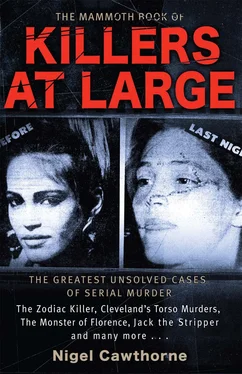The pillows were covered in blood, indicating that she had been asleep in bed when she was attacked. Then she had been dragged to the floor and her nightdress pulled up. Her naked midriff was raised on a pile of blankets and her genitals exposed, so it was thought that she had been raped by her attacker.
Her eight-year-old son said that a man had come into the cabin in the middle of the night. The boy had woken up, but the man pushed him into a corner and told him to be quiet. He had placed a blanket over him and the child had passed out, possibly as the result of chloroform that had recently been stolen from a dentist’s home in Austin. The boy had no recollection of what had happened to his mother. His younger brothers, who slept in the same bed as their mother, knew nothing.
Marshal Lee’s bloodhounds failed once again. A set of shoeless footprints led to the cabin. At the time, Eliza’s husband was in prison and it was not thought she had any other boyfriends, so it seemed clear that the shoeless person was to blame. Marshal Lee quickly arrested a 19-year-old, slightly backward black youth who walked around barefoot. But when the tracks were compared against his, it was clear that he had not made them. Another African-American male who had once lived with Eliza was arrested. He had no alibi and had recently quarrelled with her. But he, too, was released when there was a third murder just over two weeks later.
On 23 May, another black servant girl was attacked in the middle of the night in her cabin, across the road from a beer garden. Her name was Irene Cross. This time the attacker had used a knife. But the attack was just as ferocious. Her arm had been practically severed from her body and the perpetrator had stabbed her so viciously in the head that she appeared to have been scalped. This time there was no suspect at all and no arrest was made.
The newspapers blamed the influx of migrant workers. Austin was then a city of just 23,000 people. But Texas was just recovering from the Civil War and the Reconstruction era and the attacker could have been any one of the thousands of strangers who had come to town, attracted by the prospect of work. There were even gangs of convicts employed in public building works. The newspapers were also unanimous that a black man was to blame—again, perhaps, a hangover from the Civil War.
A fourth attack took place on 29 August at the home of livery-stable owner Valentine Weed on Cedar and San Jacinto Streets, a block south of where Eliza Shelley had been raped and murdered. Weed’s servant Rebecca Ramey had been attacked while she slept and left unconscious while her 12-year-old daughter Mary was dragged outside into an alley and brutally raped. Then she was stabbed through both ears with an iron rod and died sometime later. Rebecca survived but could remember little of the attack.
This time, the bloodhounds set off after a black man who was walking nearby. He was arrested, but released the next day. Even though news of the killings filled the papers, the white middle classes felt they had nothing to fear. However, their servants insisted on keeping the windows closed in the sweltering heat of summer. Soon the papers were gunning for Lee, who was now widely perceived as incompetent.
On 26 September, Lucinda Boddy, a cook in a house near the newly founded University of Texas, went up to the nearby home of her friend Gracie Vance to tend her during an illness. Gracie lived in a servant’s cabin behind the house of her employer, the attorney Major W. D. Dunham, with her boyfriend, Orange Washington. There was possibly a fourth person present, another servant girl named Patsie Gibson.
That evening Washington and Gracie had a row. The argument was so furious that the major overheard it and had reported it to the police. But by midnight, everything was quiet and everyone was asleep. At around 2 a.m., someone climbed in through the cabin window. Gracie woke and screamed. Orange jumped up, but a blow from an axe felled him, crushing his skull. Lucinda was also hit on the head, fracturing her skull. It seems she was raped and she blacked out. Patsie, too, had been badly beaten, possibly with a sandbag.
The attacker then dragged Gracie Vance out of the cabin and into some bushes near the stable, where she was also raped. It seems she put up a terrific fight before the killer finished her off by beating her skull with a brick.
During the attack Lucinda came round and lit an oil lamp to have a look around. She saw Orange lying unconscious on the floor and another man was in the room.
“Don’t look at me,” he said and, cursing, told her to put the light out. Instead, she threw it at him and ran. Her screams alerted the major, who came out of the house with a gun.
“We’re all dead!” Lucinda screamed at him before she passed out again. He noticed the blood on her clothes and crept gingerly into the cabin. There he found Washington lying in a pool of blood on the floor. Beside him was an axe. Knowing of the other attacks on black servants in the area, the major called his neighbours for help.
Soon after he found Gracie’s body. Her head had been turned to pulp and a bloody brick lay by her corpse. In her hand was a gold watch that did not belong to her, its chain wrapped around her arm. According to one source, a strange horse was found, saddled, in the stable. But neither the watch nor the horse led the authorities to the culprit.
Vigilante committees were set up and there were calls for all undesirables to be run out of town. The circumstances of the last attack indicated it was possible that more than one assailant was at work. Marshal Lee promptly arrested two black men, Dock Woods and Oliver Townsend. It seems that Lucinda Boddy implicated Woods, who was known to harass Gracie. When he was arrested, he was in possession of a blood-soaked shirt. Another witness claimed to have overheard Wood’s friend Town-send, a petty thief, threaten to kill Gracie.
Lee also invited professional detectives from the Noble Detective Agency in Houston to assist him in the investigation. They immediately extracted a confession from a man named Alec Mack, who admitted killing Mary Ramey. But Mack said that they had threatened to lynch him unless he confessed. Bruises were found on his body from a beating. Lee said that Mack had sustained them resisting arrest. But confidence in Lee and his Houston detectives was so low that Mack, Woods and Townsend all had to be released. Lee then turned to an even more unlikely suspect. He arrested Walter Spence, who had been injured in the attack on Mollie Smith. After a three-day trial, Spence was acquitted.
It was clear that Lee’s idea of going after suspects that might have had a motive in a single case was not working. Instead, state prosecutor E. T. Moore speculated that all the murders had been committed by a single culprit who hated women. No one had heard of such a thing before and he was mocked. Nevertheless, Lee was sacked from the case and a new marshal, a former Texas Ranger named James Lucy, was brought in.
Up until this point all the victims had been black. But that was to change on Christmas Eve 1885. After attending a concert at the State Institution for the Blind, Moses Hancock had been dozing in a chair at his home on San Jacinto Boulevard. When he woke he found his wife Susan missing. She had been dragged from her bed. He found her lying dead in the back yard, her head cleaved open with an axe, and a sharp, thin implement was sticking out of her brain. Blood was pouring from her ears and soaking into her hair. Amazingly she was not dead, though she never regained consciousness. It was also plain that she had been raped. But unlike the other victims Mrs Hancock was white.
Like his predecessor, Marshal Lucy brought in the bloodhounds. Again they drew a blank, but the killer had not finished for the night. Within an hour, society beauty Eula “Luly” Phillips was dead. One of the loveliest women in Austin, she had dark curly hair, pale skin, doe eyes and an exquisite figure that turned men’s heads in the street. She lived with her husband and infant son in her father-in-law’s house in one of the richest neighbourhoods of Austin. But although she was married to the son of a prominent citizen, it seems that she also entertained other distinguished lovers.
Читать дальше











